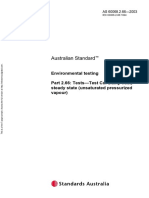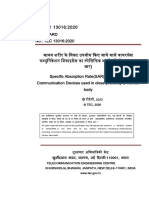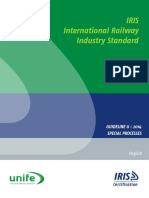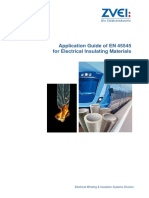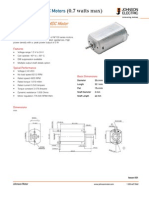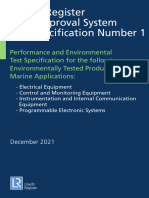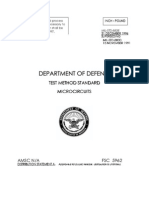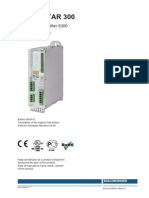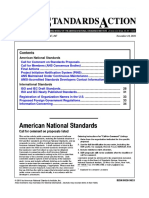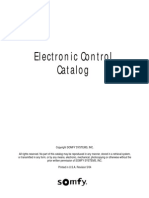FACT SHEET
UL 1973
TESTING & CERTIFICATION
Stationary Battery Cell, Module and Unit Evaluation
Intertek’s experience
and expertise evaluating
batteries offers
manufacturers the
guidance they need to
comply with certification
requirements within UL
1973.
UL 1973 Evolution may or may not be present. For instance, provides crucial monitoring parameter
UL 1973 was developed primarily to a cooling system may be absent during information to the system BMS, enabling
evaluate secondary batteries for the evaluation of a battery module. it to take preventive actions as needed.
Battery modules from the design Cells
stationary and Light Electric Rail (LER)
perspective are not complete in nature,
applications. The initial release of the i.e. it requires additional material/ UL 1973 references other standards or
standard included safety aspects for resources to be fully compliant to annexes for cell evaluation across various
Lithium, Sodium Beta, and Flowing standard requirements. Due to this chemistries: Nickel Metal Hydride (UL
Electrolyte type batteries, with cell-level reason, battery modules are mostly 2054), Secondary Lithium Cells (UL 1973
evaluation covered by other standards. recognized components with Conditions Annex E), Sodium Beta Cells (UL 1973
of Acceptability (CoAs). Annex B), Flowing Electrolyte Stacks and
Battery Systems (UL 1973 Annex C), and
Currently, Edition 3 of the UL 1973 Some battery systems require auxiliary for vented or valve-regulated lead-acid
standard is in use, encompassing Valved power from outside the system in the or nickel-cadmium batteries (UL 1989, UL
Regulated Lead Acid batteries and Nickel form of AC supply. In such cases, the 1973 Annex H). Sodium ion cells are
Metal Hydride batteries. This version also standard incorporates tests related to AC covered under UL 1973 Annex E.
supply.
incorporates requirements for evaluating Repurposed cells or batteries undergo UL
Lithium cells. 1974 evaluation.
Battery Management System (BMS)
General An important part of a battery is the
Key Dates
UL 1973 is designed to validate battery Battery Management System (BMS),
which houses all critical safety functions. • 2013: UL 1973 initial version
compliance at the cell, module, and unit
The BMS executes these functions was released
levels with Battery Management Systems
through hardware or software. It is • 2018: second edition was
(BMS) for Lithium-based batteries. It also
capable of monitoring voltages, released with revisions to
encompasses other technologies at the
temperatures, and currents at the cell existing tests and some
module and unit levels.
level, depending on the configuration of construction requirement
UL 1973 includes two types of changes.
applications for the battery under the battery module. Using this
information, the BMS can regulate • 2022: Third Edition was
evaluation: stationary applications for released with some additions
Battery Energy Storage Systems (BESS) various parameters to prevent hazardous
situations. on testing side.
and Light Electric Rail (LER). Additional
tests specific to LER applications are Sometimes, BMSs operate at multiple
required in addition to those common to levels: at the battery module level (local)
both applications. and at the system level (remote),
overseeing multiple modules. In this
Depending on the level of evaluation,
multi-layered BMS system, the local BMS
certain components within the system
August 2024
�UL 1973
TESTING & CERTIFICATION
Frequently Asked Questions
Does the BMS require a functional
safety evaluation for UL 1973
compliance?
There are two paths for compliance
when you have a BMS in the system.
1. BMS goes through functional safety
evaluation as per UL 991 (Hardware
based critical function implementation),
UL 1998 (Software based critical function
implementation) or UL 60730-1 Annex H
(includes both Hardware and software
based critical safety function
implementation).
2. BMS is provided with redundancy in
which case the abnormal tests will be
performed with single fault on primary
protection for the function under test.
When these modules are used within an • Crush test (LER motive and VAP Alternate test program for secondary
Energy Storage system, the system-level applications) lithium cells
standard UL 9540 requires a functional • Static Force test
safety evaluation for the system’s safety • Short circuit
• Impact test • Abnormal charging
component, which in many cases is the • Drop Impact test
BMS. Therefore, it is recommended to • Crush
• Wall mount fixture/support • Impact
have the BMS certified for functional structure/Handle test
safety. • Shock
• Mold stress test • Vibration
• Pressure release test • Heating
What are the testing requirements of • Start to Discharge test • Temperature cycling
ANSI/UL 1973? • Environmental tests • Low pressure (altitude
ANSI/UL 1973 requires the following test • Thermal cycling test (LER simulation)
items in general for all battery types: motive and VAP applications) • Projectile
• Resistance moisture test
Electrical Tests • Salt Fog test
• Overcharge test • External Fire exposure for About Intertek
• High-rate charge projectile hazards test Intertek is a leading Total Quality
• Short Circuit Test • Single cell failure Design Assurance provider to industries
• Overload under discharge tolerance test worldwide. Our network of more than
• Over discharge protection test 1,000 laboratories and offices and over
• Temperature and operating There are some tests that are 42,000 people in more than 100
limits check test Technology specific and are provided in countries, delivers innovative and
• Imbalanced charging test the annexes of the standard. bespoke Assurance, Testing, Inspection
• Dielectric voltage withstand test and Certification solutions for our
• Continuity test customers’ operations and supply chains.
What are the testing requirements of
• Failure of cooling/thermal
stability system lithium cells?
• Working voltage measurements UL 1973 Annex E provides a list of tests
• Tests on Electrical components that need to be performed on lithium-ion FOR MORE INFORMATION
• EMI tests (may be waived if cells or other secondary lithium cells
performed on BMS during • Short circuit +1 800 WORLDLAB (967 5352)
functional safety evaluation) • Cell impact
Mechanical tests • Drop impact icenter@intertek.com
• Vibration test (LER motive and • Heating
VAP applications) • Overcharge
• Shock test (LER motive and VAP • Forced discharge intertek.com/energy
applications) • Projectile
August 2024











